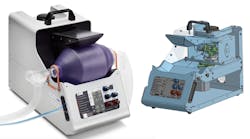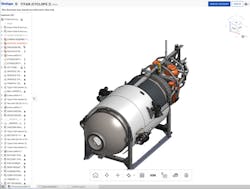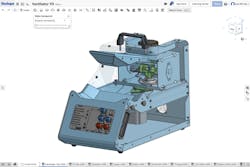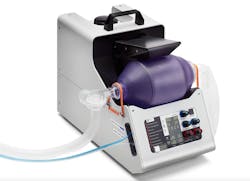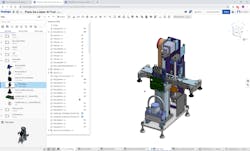During the first few weeks of the coronavirus pandemic, when software engineers and other white-collar professionals were singing the praises of Zoom and thriving in a work-from-home environment, many mechanical engineers found themselves suddenly unable to easily access their designs. Software engineers and much of the business world (sales, marketing, accounting, human resources, etc.) have long used cloud-based productivity tools, but most hardware designers were still using installed on-site software for product development.
The government shutdown of non-essential businesses around the world forced many engineering departments using desktop-installed CAD and product data management (PDM) systems to scramble. On-site CAD licenses are tied to a single computer. For those engineers without high-performance laptops, much of their most important data lived in their desktop at their inaccessible workplaces. Getting access to critical data required dealing with VPNs to access the office network and the company’s PDM system. It involved making sure their software licenses authorized them to use their design tools on their home computers—assuming those computers were powerful enough to run CAD software in the first place.
Instead of designing products as they were hired to do, many engineers have been preoccupied with IT burdens. For users of installed design tools, collaborating with their colleagues and external partners have presented additional challenges. File-based PDM systems require a serial workflow, allowing only one engineer at a time to work on a design. Sharing CAD files with a colleague must be done by email or by uploading to a file-sharing service such as Dropbox—adding additional lag time between rounds of feedback.
These obstacles, of course, existed long before the COVID-19 crisis. But the shelter-in-place mandates have magnified the downside of installed product design software and have resulted in greater exploration of cloud-based software-as-a-service (SaaS) alternatives.
SaaS Advantages
SaaS CAD and data management platforms give distributed product design teams the flexibility to work together from any location. Engineers can access their work and their design software from any computer, tablet or phone via a web browser or mobile app (iOS or Android) without delay. If one computer shuts down or malfunctions, work can continue uninterrupted on another device.
Regardless of where an engineering team is working—different floors, different office buildings, different states or different countries—SaaS product development tools allow team members to work as if they are in the same room looking over each other’s shoulders. Unlike with file-based CAD and PDM systems, multiple engineers can simultaneously work on the same 3D CAD model online and provide immediate feedback with the same ease of posting a comment on social media. There is no need to email screenshots back and forth or deal with downloading file attachments.
Real-time data management enables everyone on the team to see design changes as they happen. Similar to the change history in Google Docs—where you can see every time-stamped revision of a document—a comprehensive edit history allows engineers to see who on their team made which changes to the product model and when. If the product design goes in an unintended direction, a SaaS CAD platform allows the team to instantly revert back to any prior stage of development, making it easier to take creative risks.
SaaS design platforms also help companies better protect their intellectual property. CAD models can be shared with colleagues and external partners with varying levels of access permissions—view-only, commenting and editing rights—that can be changed or revoked at any time. The product design only lives in one centralized place in the cloud. There are no uncontrolled file copies floating around the hard drives of former employees or contractors.
Lastly, using cloud-native platforms over on-site software results in a significantly reduced IT burden for companies. SaaS requires no downloads, installs, license codes or server maintenance. New CAD features and functionality are added in regular automatic updates, a sharp contrast with installed software upgrades that can interrupt work for hours or days.
Applications
How much of an immediate impact can SaaS collaboration tools have on product development? Perhaps the most dramatic example is the Rise Emergency Ventilator, which was recently designed from scratch, built and clinically tested in 21 days—a process that normally would take many months. Meter, a San Francisco- and Boston-based industrial hardware startup, shifted its full resources in March and April to developing a ventilator that can be affordably manufactured at high volumes.
The Rise Emergency Ventilator was designed with readily available components in the supply chain so it would not compete for high-demand parts needed for existing ventilators in the field. Any factory that can currently build consumer electronics is equipped to mass-produce Rise ventilators without the need for medically specialized manufacturing.
Bringing any product from an idea to market in three weeks is a daunting task under normal circumstances, let alone when most of the key contributors are confined to their homes. Eduardo Torrealba, the co-founder and CEO of Meter, said using a cloud CAD platform was vital for enabling real-time collaboration between his in-house engineers and external partners working on 3D-printed prototype parts and sheet metal fabrication.
“I think the fact that the tool is always live was really important for us,” said Torrealba. “We had several design reviews conducted over Zoom where 8 to 10 people would be on a call. Somebody would share their screen and they would be live manipulating the model. And then if someone had a question, they didn't just have to say, ‘Okay. Turn it around. Spin it. Do this. Do that.’ They could be in the workspace with the presenter, highlight things and collaboratively make edits together.
“This approach was just incredibly valuable for us,” Torrealba continued. “We were moving too fast to deal with emailing files around or setting up servers, or a lot of the other things that we would need to do to have that same level of collaboration with an installed CAD package.”
In Seattle, OceanGate, a developer of manned submersible vehicles for scientific research and adventure travel, also found SaaS product design tools to be invaluable during the pandemic’s shelter-in-place mandates. The company’s seven-person engineering team is currently designing a sub for its Titanic Survey Expedition scheduled for summer 2021.
“The greatest part about cloud-based CAD is that I can always see everything that my team is doing,” said Dan Scoville, OceanGate’s director of engineering and operations. “Our team has recently been working on this ‘dropping legs’ mechanism to let the pilot shed weight in the case of an emergency. It’s a deep backup feature and I can just pop into the design and see how it’s going. It’s also valuable for getting quick feedback from our CEO. We can both be in the model and he can say what he likes, what he doesn’t like, bring up issues and offer suggestions.”
Pre-COVID SaaS Conditions
Pandemic-related workplace challenges aside, SaaS product development tools have proven to be especially useful to companies with distributed teams across multiple locations.
Medical research equipment manufacturer Formulatrix, which serves about 95% of the protein crystallization imaging market, has 15 mechanical engineers in the U.S. working closely with 85 counterparts in Indonesia—and an additional 100-plus engineers in software integration, process engineering and manufacturing.
“We do everything in-house and our iteration cycle is very rapid. We’re able to design and build prototypes in a matter of days versus weeks or months,” said Heinrich Köchling, director of worldwide engineering at Formulatrix. “One of the biggest reasons we use a cloud-based platform is its collaborative capabilities. The ability for our American team and our Indonesian team to work together in real time is extremely valuable. The time difference is 12 hours and we were losing a lot of time when we used to have to send files back and forth.”
Another ancillary, but impactful, benefit of SaaS product development tools is their ability to significantly increase the size of the recruiting pool for remote-friendly jobs. If you’re looking for the best engineering talent, why restrict your search to a 50-mile radius when you can cast your net worldwide?
Darren Garnick is the content director for Onshape at PTC.
